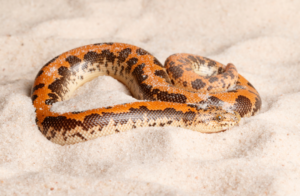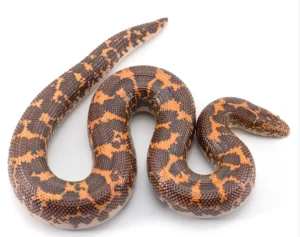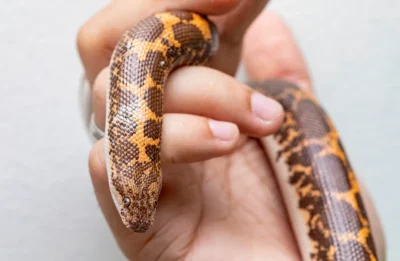Sand boas, with their unique appearance and intriguing behaviors, captivate the curiosity of reptile enthusiasts worldwide. Among the myriad of questions that arise about these fascinating creatures, one of the most common is, “How big do sand boas get?”
The size of sand boas can vary depending on their species, gender, and individual genetics. Generally, they are relatively small snakes compared to other boa species, typically ranging from 12 to 24 inches in length as adults.
However, some larger species, like the Kenyan sand boa (Gongylophis colubrinus), can reach lengths of up to 3 feet or more. Female sand boas tend to be larger and heavier-bodied than males. Their compact size makes them popular pets among reptile enthusiasts, as they require less space and are easier to handle compared to larger snake species.
Importance of understanding sand boas size

Understanding the size of sand boas is fundamental for any enthusiast or caretaker of these fascinating reptiles. Sand boas, belonging to the Boidae family, are known for their burrowing behavior and unique appearance. As with any animal, comprehending their size holds significant importance across various aspects of their care and management.
Firstly, grasping the size of sand boas is essential for creating suitable living conditions. These snakes require adequate space to move, burrow, and thermoregulate within their enclosure. An enclosure that is too small can lead to stress and behavioral issues, while one that is too large may make it difficult for the snake to locate its hiding spots or regulate its body temperature effectively.
Additionally, understanding their size is crucial for providing appropriate nutrition. Sand boas, like other snakes, require prey items that are proportionate to their size. Offering prey that is too large can result in digestive issues or even regurgitation, while prey that is too small may not provide sufficient nutrition. By knowing the size of the snake, caretakers can select prey items that are suitable and promote optimal health.
Moreover, monitoring the size of sand boas is essential for health assessment. Regularly measuring and tracking their size allows caretakers to identify any abnormalities or signs of health problems promptly. Changes in size, such as sudden weight loss or gain, can indicate underlying health issues that require attention from a veterinarian.
How big do sand boas get?
Sand boas typically grow to be about 18 to 24 inches (45 to 60 centimeters) in length. They have a stout body and are known for their distinctive sandy coloration and pattern, which helps them blend in with their desert habitats.
While most individuals fall within this size range, some may reach lengths of up to 30 inches (75 centimeters), though this is less common. Their relatively small size makes them manageable pets for snake enthusiasts, and their calm temperament also adds to their appeal. Overall, sand boas are considered small to medium-sized snakes.
Growth Patterns of Sand Boas
The growth patterns of sand boas can vary based on factors such as genetics, environmental conditions, and feeding habits. Typically, sand boas grow rapidly during their first year of life, with noticeable increases in length and girth. After reaching maturity, their growth rate slows down significantly, and they may continue to grow slowly throughout their lifespan.
During their initial growth phase, which lasts about a year, sand boas may experience growth spurts, especially after shedding their skin. Regular shedding indicates healthy growth and development. Proper nutrition is crucial during this period to support their rapid growth.
After reaching adulthood, which usually occurs at around two to three years of age, sand boas’ growth rate slows down considerably. They may continue to grow slowly, primarily gaining girth rather than length. Maintaining a balanced diet and providing adequate space for them to move and burrow is essential during this stage to ensure their overall health and well-being.
It’s important to note that individual sand boas may exhibit slight variations in growth patterns based on factors such as genetics, diet, and environmental conditions. Monitoring their growth and adjusting care accordingly, such as providing appropriately sized enclosures and adjusting feeding schedules, can help ensure their optimal growth and development throughout their lifespan.
Factors Influencing sand boas Size
Understanding Size in Relation to Health

Comparison with Other Boa Species
Sand boas belong to the family Boidae, which also includes several other species of boas. While sand boas share some similarities with other boas, they also have distinct differences in terms of size, habitat, behavior, and care requirements. Here’s a comparison of sand boas with some other notable boa species:
- Common Boa Constrictor (Boa constrictor):
- Size: Common boa constrictors are significantly larger than sand boas, with adults reaching lengths of 6 to 10 feet (1.8 to 3 meters) or more.
- Habitat: Common boas are native to a wide range of habitats in Central and South America, including tropical forests, savannas, and semi-arid regions.
- Behavior: Unlike sand boas, which are burrowers, common boas are primarily terrestrial and are often found on the ground or in trees.
- Care: Common boa constrictors require larger enclosures and a diet of appropriately sized rodents. They also need higher humidity levels compared to sand boas due to their tropical origins.
- Rosy Boa (Lichanura trivirgata):
- Size: Rosy boas are smaller than both sand boas and common boa constrictors, typically reaching lengths of 2 to 4 feet (60 to 120 centimeters).
- Habitat: Rosy boas are native to arid regions of the southwestern United States and northwestern Mexico, where they inhabit rocky desert areas.
- Behavior: Similar to sand boas, rosy boas are adept burrowers and spend much of their time underground or hidden among rocks.
- Care: Rosy boas have similar care requirements to sand boas, including a dry substrate, moderate temperatures, and a diet of appropriately sized rodents.
- Dumeril’s Boa (Boa dumerili):
- Size: Dumeril’s boas are intermediate in size between sand boas and common boa constrictors, typically reaching lengths of 4 to 6 feet (1.2 to 1.8 meters).
- Habitat: Dumeril’s boas are native to Madagascar and are found in a variety of habitats, including dry forests, scrublands, and rocky areas.
- Behavior: Dumeril’s boas are semi-arboreal, meaning they spend time both on the ground and in trees. They are also skilled climbers.
- Care: Dumeril’s boas require similar care to common boa constrictors, including larger enclosures, higher humidity levels, and a diet of appropriately sized rodents.
While sand boas share some characteristics with other boa species, such as their status as constrictors and their preference for burrowing, they have unique traits that make them distinct. Understanding the specific needs and characteristics of each species is essential for providing proper care in captivity.
Feeding considerations of sand boas based on size
Feeding considerations for sand boas vary based on their size and developmental stage. Here’s a breakdown of feeding considerations for sand boas based on their size:
- Hatchlings and Juveniles (Up to 1 year old):
- Hatchling and juvenile sand boas typically feed on appropriately sized newborn mice or pinky mice. These prey items provide the necessary nutrients for rapid growth during the early stages of development.
- Feed hatchlings and juveniles approximately once every 5 to 7 days, adjusting the size of the prey item to match the girth of the snake’s body. The prey item should be no wider than the widest part of the snake’s body.
- It’s essential to monitor hatchlings and juveniles closely during feeding to ensure they consume their prey items without difficulty.
- Subadults (1 to 2 years old):
- As sand boas reach subadult size, they can transition to larger prey items such as fuzzies or small adult mice. These prey items provide more substantial nutrition to support continued growth and development.
- Feed subadult sand boas approximately once every 7 to 10 days, adjusting the size of the prey item as needed to match the snake’s girth. The prey item should still be no wider than the widest part of the snake’s body.
- Subadult sand boas may exhibit increased feeding responses and growth spurts during this stage, so monitor their growth rate and adjust feeding frequency and prey size accordingly.
- Adults (2 years and older):
- Adult sand boas typically consume adult mice or small rats as their primary prey items. These prey items provide the necessary nutrients to maintain their size and overall health.
- Feed adult sand boas approximately once every 10 to 14 days, adjusting the size of the prey item as needed to match the snake’s girth. The prey item should still be appropriately sized to prevent overfeeding or regurgitation.
- Adult sand boas may have reduced metabolic rates compared to younger snakes, so they require less frequent feeding. Monitor their body condition and adjust feeding frequency as needed to maintain a healthy weight.
Regardless of size, it’s essential to offer pre-killed prey items to sand boas to prevent injury during feeding. Additionally, always provide fresh water in a shallow dish for hydration. Monitoring the snake’s body condition and adjusting feeding frequency and prey size accordingly is key to promoting optimal health and growth throughout their life stages.
Conclusion
You can learn how big do sand boas get on this page. Sand boas typically grow to be about 18 to 24 inches (45 to 60 centimeters) in length, with some individuals reaching lengths of up to 30 inches (75 centimeters). Their size is influenced by factors such as genetics, feeding habits, environmental conditions, and age.
Understanding the natural growth patterns and size variations of sand boas is essential for providing appropriate care and ensuring their well-being in captivity. Overall, sand boas are considered small to medium-sized snakes, making them popular choices among reptile enthusiasts.

